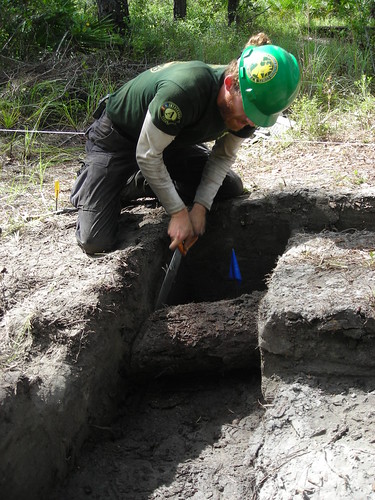
The drive to Fort Gadsden’s Historic Site on the Apalachicola National Forest is something reminiscent of a nature documentary. Towering pines line the highway while vibrant wildflowers bloom throughout the fields. Local volunteers and Apalachicola National Forest employees are busily working in the stifling heat on a restoration project at this National Historic Landmark, the only one located in the southeast on National Forest Service land. The volunteers include: a team of workers from Colorado called ‘HistoriCorps,’ and a cadre from the Texas Conservation Corps at American Youthworks.
“Without volunteers like us, a lot of these things just go to waste and rot away because nobody has the money, the time, or the work force to do it,” said Amanda Tulley, a HistoriCorps partner from Denver.
Sited on the east bank of the Apalachicola River, Prospect Bluff was once a bustling British trading post, and later a recruitment center for escaped slaves and Seminoles to thwart American expansion until the British Fort’s destruction in 1816. Although the land was under Spanish ownership at the time, the United States returned to build Fort Gadsden in 1818.
Making the central kiosk for displaying artifacts at the site compliant with the Architectural Barriers Act Accessibility Standards is just one of the many projects the group plans to complete. The Architectural Barriers Act requires that federally owned, leased or financed buildings be accessible to disabled persons.
“Our goal is to encourage visitation and improve both visitor accessibility and how the site’s story is conveyed to the public,” said project coordinator Rhonda Kimbrough, archeologist for the National Forests in Florida. “We received funding as part of the 50th anniversary of National Historic Preservation Act, which will enable us to restore the site for our 200th anniversary celebration in late February 2016.”
While the reasons vary for each individual’s involvement, the underlying sentiment remains clear; these volunteers are all truly passionate about the preservation of Fort Gadsden and feel its history serves an important purpose in America.
“It’s important, simply because if we forget our history we really won’t have any direction for our future,” said John Bales, a volunteer from Hannibal, Missouri.
It may be the picturesque scenery, the overwhelming feeling of the fort’s rich history, or the varied plant and wildlife that is amazing, but when these volunteers speak their passion is contagious. If you’re looking for a quick and easy get-away from the mundane day-to-day, visit Fort Gadsden. It’s only 1.5 hours outside of Tallahassee and is an experience you won’t soon forget.

